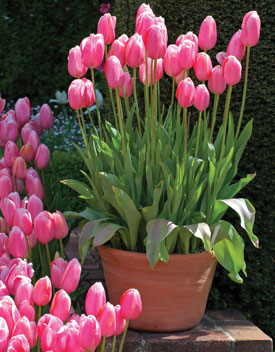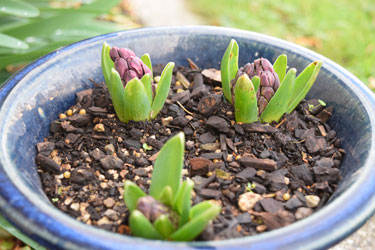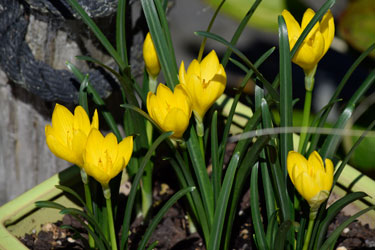Grow spring bulbs in pots
Autumn is bulb planting time. We have a good three months (more in the north), to get them planted, but for the pick of the season’s best, its best to buy early in the season.
Once you have your bulbs your most important priority is a well drained soil or potting mix. If your soil lies heavy and wet in winter, opt for pots. Alternatively build a raised garden bed. The ideal garden soil is well-drained and worked to a loose friable texture with plenty of humus added. Before planting, add bulb fertiliser and mix it thoroughly with the soil. To sweeten very acidic soils apply about 100g of dolomite lime per square metre.
Cool climate bulbs
No tulip will flower successfully year after year in a warm climate but they - and other bulbs of cool climate origin - can be enjoyed as annuals in pots with fresh bulbs planted every autumn for a beautiful spring display.
You can improve the quality of your tulip blooms (whatever your climate) by chilling your bulbs for six to eight weeks prior to planting. Make sure the bulbs are not in a part of the fridge where they are prone to freezing as this will destroy them. Also, make sure there are no fruits in with your tulip bulbs. The ethylene gas they emit is detrimental to flower production. The warmer your climate, the longer you should leave your bulbs in the fridge and the later and deeper you should plant.
A false winter chill after planting is even more effective, especially for hyacinths and crocus, as it allows root development. Ideally bulbs should be chilled at about 4ºC for 8 12 weeks to form a good root system. In a cold climate it will be enough to place pots in a cold frame or bury them in the coldest part of garden. In a warm climate they should be placed in the fridge for several weeks or the pots kept in a cool place outdoors and periodically topped with ice.
When the green tips appear, move pots to a cool room with indirect light while shoots develop. When flower buds appear they can be move to pride of place with plenty of natural light but the flowers will last longer if they are kept relatively cool, away heater and direct sun.
Bulbs can only be forced to flower earlier than their natural season once, as it strains their resources. Discard them after flowering or plant them out in the garden where they’ll often recover to flower in spring the following year.
Any-climate bulbs
Heralding the change of season, daffodils radiate colour and fragrance into the last grey days of winter. They are native to the northern hemisphere, especially Spain and Portugal and most varieties grow well throughout New Zealand. Some, are exceptionally well suited to warmer climates. 'Paper White' and 'Soleil d' Or' daffodils respond to the slightest winter chill.
Daffodils are favourites for ‘naturalising’ in the garden but they also look great in pots. It’s fun to prepare several pots at ten day intervals, bringing them indoors to a sunny warm position as their green shoots pop up, with others waiting in the wings for a later display.
A stunning colour contrast to daffodils, bright blue grape hyacinths (Muscari) grow easily in any climate. Elegant Dutch irises, in shades of blue, yellow and white, will flower beautifully in most parts of the country provided they have excellent drainage and plenty of sunshine.
Warm climate bulbs
South African bulbs; Freesia, Tritonia, Ixia, Lachenalia, Sparaxis, and Babiana, also little blue Ipheion from South America are ideally suited to New Zealand’s warmer climates. Provided the soil is not too wet over summer, they can be left in the garden to pop up year after year, or may be left in their pots for two or three years without repotting. The way to grow these frost tender bulbs in cold climates is to plant them in pots moved into shelter for winter or to plant in spring (after the last frost) for summer flowering.
Freesias, many of them highly fragrant, can be grown in pots for a succession flowers indoors or out. Bulbs flower eight weeks after planting, and continue to bloom for up to eight weeks. Plant a pot every three or four weeks from now until August and you’ll have flowers throughout winter and spring.
Brightly coloured lachenalias are especially good for pots or hanging baskets. For a stunning show in a hanging basket plant lachenalias around the entire basket with the point of each bulb facing outwards. The flowers will find their own way upright once sprouted.
Spring bulbs in pots
Spring flowering bulbs thrive in pots and are some of the best plants you could choose for container planting at this time of year. If your garden soil is on the heavy side, switch to growing your bulbs in pots. The best results come from top quality, new seasons bulbs planted into clean pots of fresh potting mix.
- Always plant in fresh potting mix.
- Plant generously so that the pots look full. Large bulbs, such as tulips can be almost touching. Bulbs which have bushy foliage, such as freesias should be spaced about 2cm apart.
- After planting place the containers in a cool place until the shoots appear. Then bring them out into a sunny position for flowering.
- Drainage is further improved by sitting pots on spaced bricks or special pot feet.
- To keep cool climate bulbs such as hyacinths really cool, sink pots onto the ground until the shoots appear. Watch for slugs and snails though! Snail bait is highly recommended for all bulbs.
- Keep the potting mix moist, but not wet throughout the growing season.
- Invest in a planting mix containing controlled release fertiliser and supplement with fortnightly feeds of liquid fertiliser from the time the first shoots appear until the leaves start to turn yellow. This encourages best quality blooms and healthy bulbs for planting out next year.
4-Apr-2014

Tulips in a terracotta pot

Hyacinths in a pot

Crocuses in a pot


